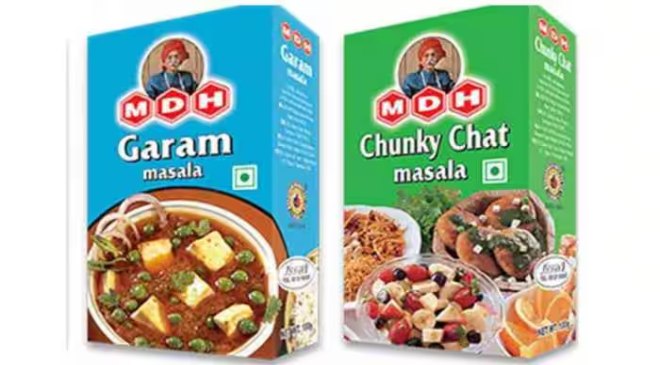New Delhi: In 2021, the Union Ministry of Commerce and Industry’s Spices Board had issued guidelines for exporters to prevent contamination of spices and spice products with ethylene oxide, an established carcinogen, in their supplies.
Read More:Jaipur Leads AI Job Growth In India’s Tier 2 Cities, Report Reveals Top Roles
These comprehensive rules were preceded by an alert from the European Union’s Rapid Alert System for Food and Feed (RASFF), a database aimed at identifying and updating health-related risks via food products. The EU flagged the presence of the toxin in the spices exported from India.
Ethylene oxide, a food fumigant that prevents microbial contamination, has been classified as a group 1 carcinogen by the World Health Organization’s International Agency for Research on Cancer (IARC).
However, last week, high levels of the same compound, which is often used to sterilise medical equipment, were detected in various samples of two of the most popular Indian spice brands — MDH and Everest — by authorities in Hong Kong and Singapore, prompting them to ban these products.
Following the Spices Board’s guidelines for exporters, the Food Safety and Standards Authority of India (FSSAI) had also planned to adopt them, in an attempt to get spice makers to follow the same norms for spices produced for local consumption, sources in the Union health Ministry told ThePrint.
But there is no indication, so far, of the food regulator adopting or issuing these guidelines for the nearly 56,188 registered licence holders, who manufacture spices in the country.
The Food Safety and Standards Act 2006, aimed at ensuring “availability of safe and wholesome food for human consumption”, bans the presence of any amount of ethylene oxide in food products. But, does it also imply that Indian consumers are protected from this hazard?
The consumers wouldn’t know because these products are not tested for contamination.
A senior FSSAI official told ThePrint that while several countries, including the US, Singapore, Hong Kong and the European Union, permit a certain level of ethylene oxide, it is banned in food products in India.
“In fact, our norms are stricter, when it comes to this particular contaminant. As it is totally banned in food products, we don’t check for this contamination in our routine surveillance,” he added.
However, the latest episode has pushed the regulatory authority to carry out the safety test. “We are checking spice samples from across India for this contamination now and the results will be available in a few weeks,” the official said.
ThePrint reached FSSAI Chief Executive Officer G. Kamala Vardhana Rao via calls and emails. This report will be updated if and when a response is received.
Food safety act violations
According to FSSAI data, a total of 1,77,511 food samples were tested across India in 2022-23 as part of the routine surveillance exercise to check the quality of food products. These included dairy, vegetables, pre-packaged food and spices being sold in the market.
Of these, 44,626 products, or 25 percent, were found to be non-conforming — either unsafe or substandard, or misbranded/mislabeled, or attached with misleading advertisements.
Another worrying discovery was that 6,579 food products, 3.7 percent of the ones tested, were declared “unsafe” — defined under the FSS act as items whose nature, substance or quality is so affected as to render them injurious to health.
In 2023-24, for which only provisional data is available, a total of 24,794 out of 1,22,795 analysed samples, or more than 20 percent, were deemed non-conforming.

So, over the past two years, several food products in the Indian market have been found to be in violation of the food safety act.
A food safety expert, however, argued that the data shared by the FSSAI does not mention it explicitly, but a majority of the samples collected are mainly tested for adulteration, and very few for contamination.
“That’s because checking for contamination, or presence of pesticide residues, antibiotics, heavy metals and natural toxins, is a very resource-intensive exercise that requires high quality labs and trained personnel, which the agency seems to be lacking,” he said.
Read More: India’s first Upgradable ATM launched! What is it? Features, benefits and other details

The FSSAI official quoted above, however, countered this claim, saying that the regulator has an annual budget of about Rs 370 crore, and nearly 70 percent of its 237 labs are high-end labs. “There is no major resource constraint in carrying out our work, and we are doing it well,” the official maintained.
Some of those working to improve the access of safe food products to consumers also agreed, saying that the food regulator works mostly as a reactive body, rather than keeping vigilance to ensure larger public health safety.
“Now that some countries have flagged Indian spices for toxic contaminant, FSSAI will probably test these spices, but I have never heard of them proactively checking the food products for such contamination, and making it public,” said Ashim Sanyal, Chief Operating Officer (COO) and Secretary at the Consumer Voice, a consumer voluntary action group based in Delhi.
Food safety policy, law enforcement: The key issues
“Food safety norms are crucial in any country, but they carry particular significance in developing nations like India, due to various factors, including population density, agricultural practices, and infrastructure challenges,” said Dr Mohit Sharma, senior consultant in internal medicine and endocrinology at Amrita Hospital in Faridabad.
Under India’s food safety law, offences that may include vending or manufacturing food of subpar quality, misleading representation of food products, dissemination of deceptive information through advertising, neglecting the adherence to prescribed food safety standards, and use of adulterants in contravention of regulations, can invite penalty and imprisonment — up to life sentence in extreme cases.
FSSAI statistics show that in 2022-23, 38,096 civil cases and 4,818 criminal cases were launched by the regulator against food business operators for violation of various rules, and about Rs 35.98 crore were raised in penalty. Also, convictions in 28,464 civil and 1,188 criminal cases were achieved during the period.
But, nutrition and food safety experts, like Dr Arun Gupta, convenor of think tank Nutrition Advocacy in Public Interest (NAPi), underline that these numbers do not reflect the extent of the problem.
“The advertising watchdog keeps accumulating data on misleading advertisements by packaged food brands by food giants that hide crucial information on high salt, sugar and trans fat in food items, for instance, but in reality, how many of them are penalised?” Dr Gupta asked.
The lackadaisical enforcement of the law is one concern, but there are issues at the policy level as well.
Consumer Voice’s Sanyal, for example, pointed out that the existing law does not mandate the regulator to reveal the details related to non-conforming products.
“If, by any chance, the traces of toxic contaminants in MDH and Everest spices would have been caught in India, it is possible that we would have never found out about it,” he said.
Also, food recall, in cases of violation of safety provisions, is left to business operators.
In response to a query by ThePrint, FSSAI said that under section 26 (1) of FSS Act 2006, it is incumbent upon every food business operator to ensure that their food products meet the standards or regulations, and its accompanying rules and regulations, throughout all stages of production, processing, import, distribution, and sale.
“To ensure strict adherence to these regulations, FSSAI diligently conducts routine inspections, surveillance and enforcement activities, including sampling and testing procedures, as outlined in the act,” it said.
It added that subsequent to identifying any deviations from compliance standards in surveillance data, enforcement initiatives are meticulously strategised and executed by the regulator in accordance with the procedures stipulated in the act, rules and associated regulations.
The regulator also maintained that failure to adhere to compliance standards by food business operators will result in penalties or other punitive measures.
To address the recall of unsafe products, FSSAI said, the Food Safety and Standards (Food Recall Procedure) Regulations of 2017, along with accompanying guidelines, are in effect.
“These regulations and guidelines necessitate food business operators to establish and submit a recall plan, as part of their licensing application process. This framework for food recall procedures aligns with international best practices and standards, ensuring robust measures for consumer safety,” it insisted.
But the loopholes in existing regulations and their effective implementation are a widely acknowledged problem.
The Parliamentary standing committee on health and family in 2018 had noted, “The policies and existing food laws are inadequate and are weakly enforced.”
“This poor implementation of the food law has resulted in rampant food adulteration and various food scandals. Substandard quality food has been reaching the market and causing irreparable damage to public health. The fundamental right to pure food has been compromised and long since forgotten,” the report had said.
Read More: What is the PPI Charge on UPI Payments? Who Does it Affect and What You Need to Know?
This may be a six-year-old report, but not much has changed since, as pointed out by a researcher with a New Delhi-based institution, working in the area of food safety and toxins.
Dr Debojyoti Dhar, Co-founder and Director, Leucine Rich Bio, a company that focuses on preventive healthcare and precision medicine, remarked, “To make the regulatory system a reality, a better monitoring mechanism and centralised public feedback mechanism is desperately needed.”





































